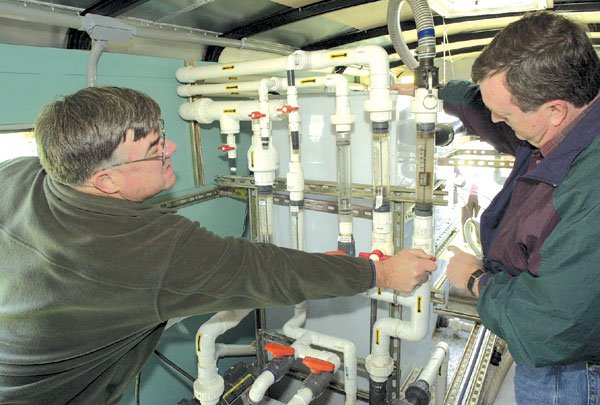SAN MARTIN
– The well on Bob Cerruti’s land in San Martin not only has the
perchlorate problem, it has nitrate problems, too. But he thinks
there just might be a solution to both not too far in the
future.
SAN MARTIN – The well on Bob Cerruti’s land in San Martin not only has the perchlorate problem, it has nitrate problems, too. But he thinks there just might be a solution to both not too far in the future.
On Tuesday, the Cerruti well – which he shares with three other families on Moreno Court – had its water drawn, zapped with electrical current and taken off to be tested. By Wednesday, results showed the nitrate level reduced from 45 ppb to 7.2, 3.8 and 9.3 ppb in three separate tests.
Results of perchlorate testing were not ready by Thursday afternoon but, if they follow previous testing, those levels too will be reduced. Cerruti’s well has tested 8.9, 8.1 and 8.4.
The ‘magic machine’ that may solve Cerruti’s water problems was developed by EXTi – Electro Oxidation Technologies, Inc. – a start-up company operating out of a San Jose garage. The Silicon Valley myth of Hewlett-Packard’s Palo Alto garage hangs over EXTi’s small staff, giving them hope.
“We believe we have a technology that works,” said Lee Deckard, who handles the business end of the operation. EXTi was incorporated in April 2002 but Deckard, Abdullah Kazi (the chief technical officer) and Roy Hays (president) have worked on pollution control technologies since 1994.
However, the technology has a way to go before the system gains official sanction, if it is able to do so.
Still, company officials are in full-speed-ahead mode to develop a system that would be marketed in the $12,000 price range.
Deckard is concerned about two things at the moment: to test the water treatment process on drinking water so appropriate levels of voltage can be determined and to get the word out that a totally new contaminate-removal process is in the works.
He did both at Bob Cerruti’s well head.
The electro oxidation system (EXSYS) – which the team designed and patented – treats dissolved organic contaminants – chemical and biological – and inorganic ions including heavy metals, nitrates and perchlorate in water. The process, Deckard said, is more efficient and costs less than other treatment methods. And, he said, the EXSYS treatment makes water recyclable.
An added bonus is that the treatment results in no undesirable by-product or residue. The reverse-osmosis and ion-exchange processes currently used are expensive and produce a brine residue that must be disposed of. That by-product is incinerated or trucked to the ocean and dumped. Dumping will be forbidden by law in 2006.
“We get rid of that,” Deckard said. “There is no (undesirable) residue from our process.”
The EXSYS process is an exercise in chemistry and electricity. It oxidizes organic contaminates and reduces inorganics to their basic and harmless elements. By-products, depending on the original contaminant, can be oxygen, nitrogen, water, carbon dioxide, hydrogen and non-toxic salts. Perchlorate is a toxic salt.
The system originally was built to deal with industrially polluted water: MTBE, TBA, gasoline, diesel fuel, benzene and ethylbenzene, toluene and xylene and others.
When Deckard heard about the South County perchlorate problem, he asked Kazi and Hays if their system could handle perchlorate as well as the other chemicals.
“We can fix that,” Hays said.
One recent EXSYS treatment of a perchlorate-contaminated well in San Martin took the levels from 5.7 to nondetect. But, because nondetect might only be 3.9, Deckard looked for water with higher concentrations of the chemical. The Cerruti well filled the bill and had the added “bonus” of nitrates to attack as well.
EXTi has treated contaminated water for PG&E, Applied Bio Systems, Western States Oil and several gas stations among others. So far all clients have been industrial and the EXSYS technology and equipment are designed for that arena. A new design to treat drinking water is in the works and Kazi, the engineer, said he is spending long hours in the lab. The team has sent a representative to South Korea to investigate quotes for building the treatment equipment.
It will take about six months to get a treatment system designed, built and certified for drinking water, Hays said.
In the meantime, more demonstrations are scheduled in Sacramento and Salinas as the team collects data to find the cheapest and most-effective instructions to give their machines. A pilot test on a well operated by the California Water Service Co. in Porterville was successful.
“A score for us is if we reduce it (the perchlorate level),” Deckard said. “It doesn’t have to get to zero. If we can remove from 5.7 to less than 4, it’s not a developing technology. It’s here.”
The Santa Clara Valley Water District spokesman said that reports of EXTi’s success are encouraging, and the district is hearing from dozens of companies interested in perchlorate removal. However, Miguel Silva, an engineer with the district, was present at Tuesday’s test and asked several questions.
“The equipment consists of a power supply thatsupplies power to reaction cell, water enters the cell, the ‘magic’ is done, the reaction takes place, the decontaminated water is discharged either through a drainage ditch or back in to the pipe and once certified, could re-enter the drinking water system,” Deckard said.
Because all water is different, deactivating contaminants requires varying amounts of current – alternating the amperage and voltage, Deckard explained. It is a function of amperes, volts and GPM (gallons per minute).
“Perchlorates don’t seem to care,” he said. “Whatever they’re zapped with, they just go away. Nitrates are trickier.”
“The power used depends on the contamination level,” Kazi said.
“Different voltages get different results,” Deckard said. And the system uses the same amount of power to run as four 100-watt light bulbs.
Four situations are targeted for design and treatment: an entire municipal system – such as Morgan Hill’s – multiple houses on one well – as on Moreno Court – a single house on its own well and an under-sink unit.
“We are completely in the dark about what it will cost,” Deckard said.
The new product must be reviewed and certified by the National Sanitation Foundation, before EXTi would be able to offer to treat drinking water. That would take about 10 to 12 weeks and costs about $12,000, depending on where it is manufactured, among other considerations. A Korean manufacturer, Deckard said, would probably be more expensive than one in Bakersfield.
“NSF is like the UL rating on electrical equipment,” Cerruti said.
Deckard hopes his team’s product will lighten the increasingly depressing perchlorate news in the area.
“I was down in Morgan Hill over the weekend and all I heard was ‘doom and gloom,’ ” he said. “It will be nice to be able to give people some good news.”
“The question is, how do we eradicate this problem at the well head?” Cerruti said. “I don’t want to wait 40 years.”
Contact Lee Deckard at 971-7655, In**@**ti.biz or visit www.EXTi.biz.















